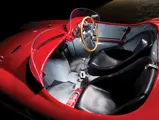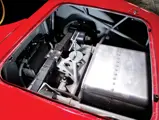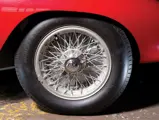Est. 260 hp, 2,999 cc DOHC four-cylinder engine, two Weber 58 mm DCOA/3 carburettors, five-speed manual transmission in transaxle, independent front suspension with unequal-length A-arms, coil springs and Houdaille shocks, de Dion solid rear axle with transverse leaf springs and trailing arms, four-wheel hydraulic drum brakes. Wheelbase: 2,250 mm
• Multiple race-winning, ex-Ernie McAfee against the likes of Hill and Shelby
• The sole 750 Monza Scaglietti Spyder built without a headrest
• Raced from 1956-63 by Masten Gregory and luminaries
• Restored in Modena to exact original specifications in 2000
• Multiple concours award-winner 2003-2006, including Cavallino Classic, Amelia Island and The Quail
• Ferrari Classiche certification
The mid-1950s was a remarkable period at all levels of automotive design, particularly at Ferrari, with each example seemingly more stunning than its predecessor. Take the flamboyant Ferrari 250 Testa Rossa with its elegant predecessor, Dino Ferrari’s timeless three-litre, four-cylinder 750 Monza. One obviously led to the other, and both share the same design paradigm. And with only 29 750 Monzas and 34 250 Testa Rossas constructed, both models represent the pinnacle of Enzo-era desirability.
The Ferrari on offer today is unique. S/n 0502 M is the only 750 Monza Scaglietti Spyder built without the customary headrest. California sportsman William Doheny bought the car for his driver Ernie McAfee to race, but Doheny intended to drive it on the street and apparently thought the headrest might attract police attention. Quite how he expected to sneak around Beverly Hills in a 164-mph race car with a straight-through exhaust was never explained.
The origins of the 750 Monza can be traced back to 1950, when Formula One attendance was declining. Ferrari was competitive at both ends of the Formula One scale, with a 1.5-litre supercharged 166M and the huge 4.5-litre un-supercharged V-12. But a 1951 meeting proposed that the Federation Internationale d’Automobile adopt 750 cc supercharged and 2.5 litres un-supercharged for Formula One in 1954, and designers scrambled to fit the bill.
Ferrari’s chief engineer, Aurelio Lampredi, proposed a four-cylinder DOHC motor, which he calculated would be lighter and have more torque. Ferrari directed him to produce it for the 2.5-litre 1954 season, and an early version, the 625 S, was tested in an F2 car at Bari in September 1951. Juan Manuel Fangio won in a 159 Alfetta, but the 625 was a surprising 3rd, driven by Piero Taruffi.
The 1952 season looked to be a disaster, when Alfa Romeo dropped out. But the World Championship was switched to Formula 2, and that meant that Lampredi’s two-litre, four-cylinder 500 F2 engine was unbeatable. The car won 17 of 19 races in the next two years, and Alberto Ascari became World Champion in 1952 and 1953.
Ferrari applied the same thinking to the sports car world, where the company had engines that were too big and heavy or smaller and not powerful enough. Enzo directed Lampredi to build a three-litre, four-cylinder engine based on the 625, and the Tipo 735 S was a narrow-angle, DOHC four-cylinder. In 1953 it was driven by the likes of Mike Hawthorn and Alberto Ascari at Monza, in the Dolomite Cup and at Senigallia, but Ferrari was convinced he was on the right track, and Lampredi made some major improvements.
750 Monza
The result was the 750, and the bore was increased to 103 mm. The narrow-valve angle cylinder head was replaced with a wide-angle 80-degree head, with bigger valves and enormous 58 DCOA/3 Weber carburettors. The engine was installed in a wider Tipo 501 GP chassis, and the 750 appeared at the Monza Supercortemaggiore 100-km race on 27 June, 1954. Umberto Maglioli and Mike Hawthorn won, and Froilan Gonzalez and Maurice Trintignant took second. The new Ferrari now had a name—the Monza.
The factory competed with the Monza through 1954-55, managing a 2nd at the Mille Miglia in 1954 and 6th in 1955, against the might of the Mercedes-Benz team of 300 SLRs, including Stirling Moss in his record-setting ride with Dennis Jenkinson, and Juan Manuel Fangio. The three-litre, four-cylinder Monzas were almost as fast as the V-12 cars in experienced hands and became the favourite mount of a number of privateers.
0502 M
S/n 0502 M was bought by William Doheny for Ernie McAfee and Harold Wheeler to drive at the 12 Hours of Sebring and delivered new in March 1955, painted in U.S. racing colours of white with blue stripes. Unfortunately, Wheeler went off the track, and the team did not finish the race. Much better times lay ahead, however, as McAfee would achieve everything Doheny intended. Doheny brought s/n 0502 M back to L.A., repaired it and painted it Dodge Lancer Royal Blue with number 76, as he was a Director of Union Oil.
Ernie McAfee
Ernie McAfee was a very popular character on the California sports car racing scene—a natural who could wrench as well as he could drive and didn’t mind helping other people do either of those things. He graduated two years early from high school and opened his own machine shop in 1937, becoming deeply involved in hot rods, dry lakes racing and the aircraft industry during WWII. At the same time, he met collectors Don Lee and his son Tommy and was hired to oversee their collection after the war, which included four 8C 2900 Alfa Romeos, the Alfa P2 in which Frank Griswold won the New York World’s Fair Race in 1940 and various Bugattis and Talbots.
McAfee left the Lees in 1950 to start his own shop on Cahuenga Boulevard, and he and Bill Devin began importing Ferraris. The two brought in the 340 America Barchetta from the 1951 Turin show, a 340 Vignale Coupé, which they sold to Masten Gregory, Devin’s own 250 MM Coupé and the 212 Vignale Coupé that Phil Hill drove to 6th place in the 1953 La Carrera Panamericana Mexican Road Race. Ernie would be racing with them soon.
Ernie McAfee’s first outing was the 1952 La Carrera Panamericana, where he finished 5th in Ferrari 340 s/n 0150 with Jack McAfee, who was no relation. After a couple of years importing and racing little Morettis and Siatas, McAfee got his big chance with Doheny’s 750 Monza. Between 29 May, 1955 and 3 December, 1955, McAfee won eight straight California races outright and only lost the ninth race to Masten Gregory in a Maserati 300S on 3 December by less than a second, in the rain. The races McAfee won included at Santa Barbara (five), Hansen Dam (two) and Palm Springs (three, with a 2nd place as a closer). Masten Gregory was quoted after the last race as saying: “The last time I was in California, Ernie was selling Ferraris, now he’s driving them!”
Doheny sensed time was about to overtake the four-cylinder cars and bought a powerful 4.4-litre Ferrari 121 LM, s/n 0546, in which Ernie McAfee scored a remarkable double victory. On 17 March, 1956 he drove the 121 LM and an OSCA MT4 to win both the over-1500 cc and under-1500 cc races at Santa Barbara on the same day. On 22 April he tried the same feat again at Pebble Beach, but his OSCA’s ignition failed when he was leading the under-1500 cc race and he DNF’d. Worse was to come.
Ernie McAfee had passed Jack McAfee in a Ferrari 857S for 3rd place in the over-1500 cc race and was chasing Carroll Shelby in 750 Monza s/n 0510 and Phil Hill, who was leading in an 860 Monza s/n 0604, when he lost control under braking. Ernie McAfee hit a tree and was killed instantly. The Pebble Beach road course was never used again.
Subsequent History of 0502 M
Doheny’s 750 Monza s/n 0502 M was sold to Temple Buell and subsequently raced by other well known drivers, beginning with Dabney Collins in 1956. He was 8th at Pebble Beach on 22 April, Jack Morton was 11th in Dodge City, Kansas on 29 April, and Masten Gregory was 2nd in the car in a later race the same day. Collins was 8th and 9th in two races at Fort Worth, Texas on 3 June, then 9th on 24 June at Elkhart Lake, Wisconsin. The talented Masten Gregory managed 2nd in Beverly, Maine on 7 July and 7th at Pomona, California on 21 October.
Lou Brero Sr. took over s/n 0502 M’s driving seat for 1957, but after two races at Paramount Ranch, California on 9-10 March, when he finished 2nd and 10th, Temple Buell sold the 750 Monza to Jack Bates. Bates drove s/n 0502 M himself through the remainder of the year, with a 5th at Pomona, California on 28 July, a DNF at Santa Barbara on 1 September, 5th at Riverside on 2 September and 5th at Pomona on 27 October. Bates made two more appearances at Paramount Ranch on 7-8 December, but results are not recorded.
There’s a record of s/n 0502 M being sold to the Jarman family in 1958, but the car does not appear to have been raced. In June 1959 it was sold to Harry Washburn of Shreveport, Louisiana. Washburn raced twice at Midland, Texas on 11 October, 1959, finishing 3rd in the preliminary and 6th in the main event. He raced twice at Hammond, Louisiana on 29 November, finishing 3rd and 2nd, then once more in Pensacola, Florida on 3 April, 1960, when he placed 8th.
The car’s final outing with Washburn was at Hilltop, Louisiana in July 1960, when it was driven by Bill Fuller to 1st place. Only one more race is recorded: 8-9 June in Courtland, Alabama, when it was driven by Neil Cargile of Nashville, Tennessee in an SCCA Regional.
In 1979, Ferrari collector Bruce Lavachek of Arizona tracked down s/n 0502 M, still in Tennessee. He managed to buy it from the parents of the deceased owner and then managed to find a correct transaxle to replace the missing original unit.
Restoration and Awards
By the mid-1980s, 0502 M changed ownership once more and ended up in the ownership of Roderick Brierly, who retained DK Engineering to complete the restoration, while Hall & Fowler conducted the engine and transmission overhaul. By the early 1990s, the car was in Japanese ownership.
The car was shown at the Rosso Rodeo meeting in Beverly Hills on 24 June, 1995. In January 1998, Bruce Perrone of Pittsburgh, Pennsylvania bought s/n 0502 M, intending to restore the car and then race it in historic events. To that end, he sent s/n 0502 M back to Modena, Italy in June 2000, for a complete restoration, with instructions for it be restored to the way it left the factory. Mechanical work was performed by Sport Auto Modena, Diena e Siliongardi and bodywork by Carrozzeria Sauto Sport Bacchelli e Villa in Bastiglia.
Perrone campaigned s/n 0502 M seriously on the concours circuit, with good results. After a colour feature in Forza magazine in May 2002, Perrone showed the car at the XIII Palm Beach Cavallino Classic in January 2004 and was awarded “Outstanding 4-cylinder,” which he would repeat the next year. He then won the Spirit of Ferrari Award at the 9th Amelia Island, Florida Concours on 12-14 March, 2004.
Perrone followed this with Best of Show at the Reading, Pennsylvania Ferrari Concours on 16 May, 2004 and showings at the Hartford, Connecticut Concours on 20 June and the 30th Annual Ferrari Club of America Concours at Quail Lodge on 17 August. An appearance at the Palm Beach, Florida International Concours on 23 January, 2005 was followed by the coveted Ferrari Classiche certificate of authenticity #161F, issued by the factory on 1 June, 2005.
0502 M has since been displayed at Retromobile in Paris, France in February 2011 and at the Techno Classica show at Essen, Germany in March 2011.
Achieving a Ferrari Classiche certificate guarantees that this superb sports racer is correct in every respect and is in its original configuration. It is eligible for the Mille Miglia, Le Mans Historic, every Ferrari Challenge event and, indeed, every historic racing event, tour or concours worldwide. The possibilities are virtually limitless. Its provenance is impeccable and its value securely confirmed. The only thing still to be established is the “fun factor” of driving one of the truly iconic Enzo-era sports racers. That will have to be determined by s/n 0502 M’s new owner.


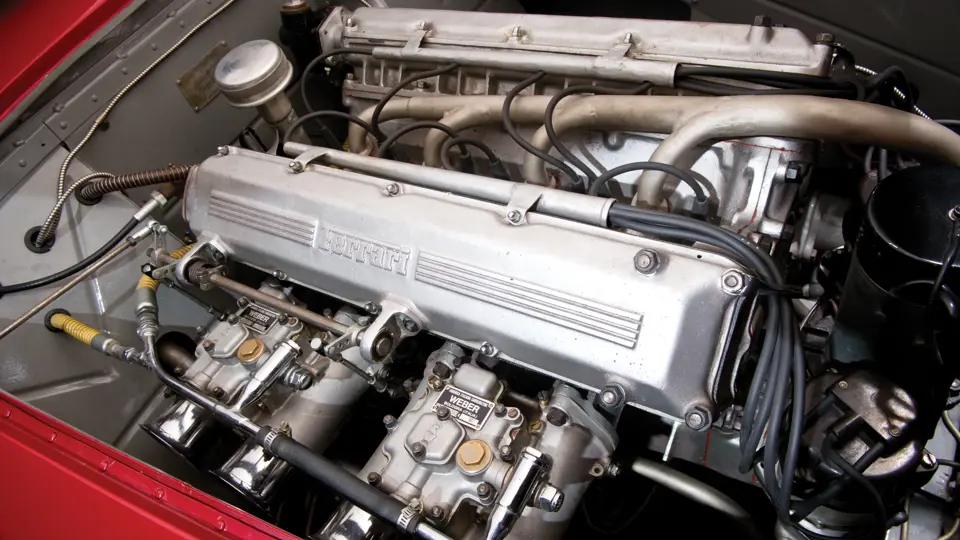


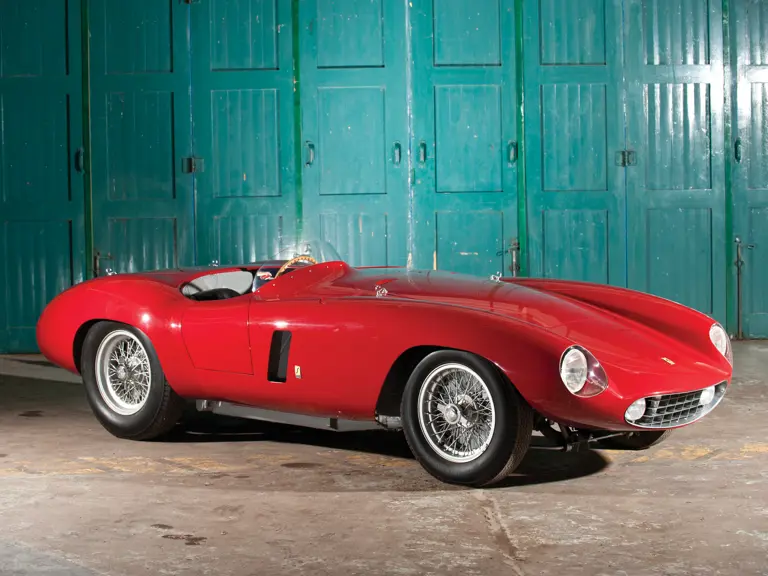






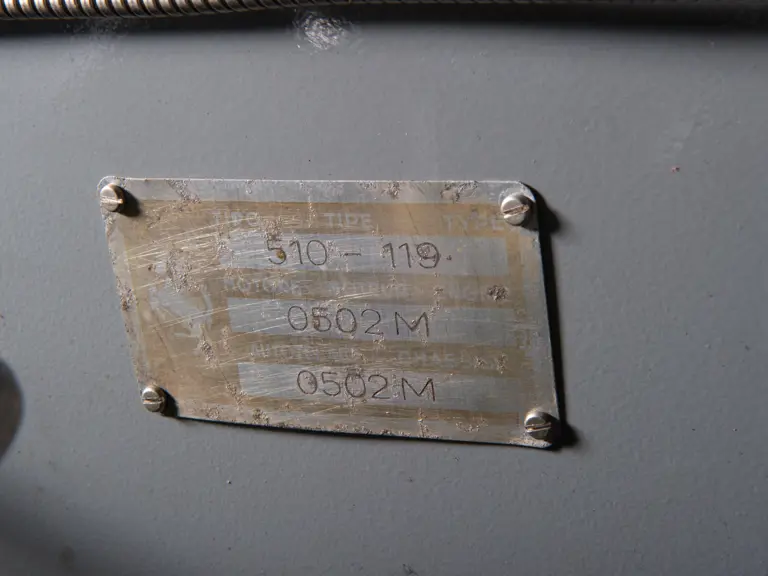














 | London, United Kingdom
| London, United Kingdom












